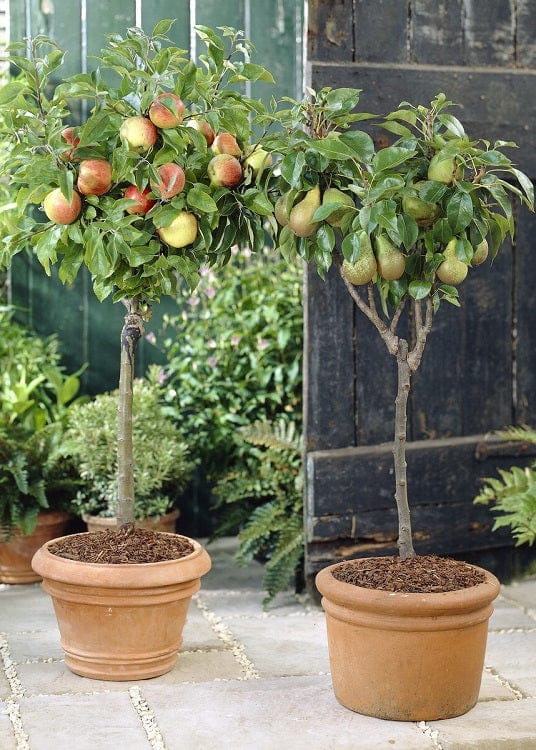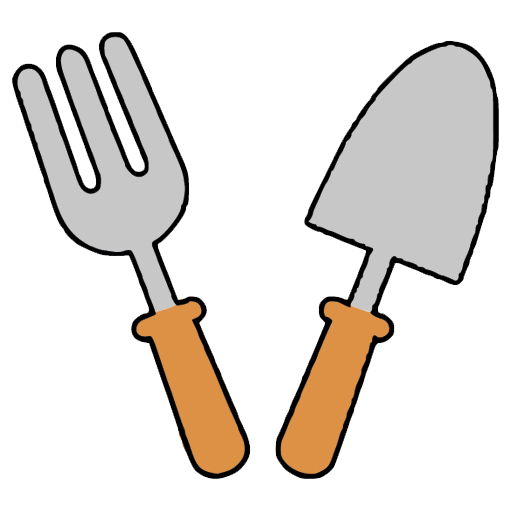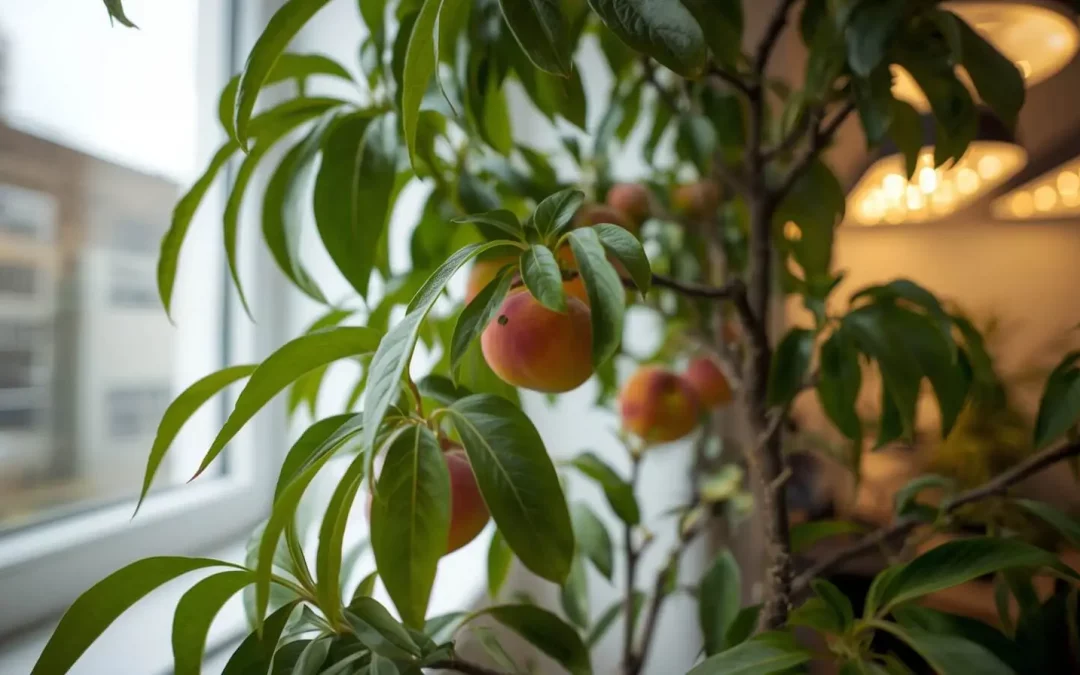Growing peaches indoors sounds ambitious, but with the right variety, container, and care routine, you can enjoy blossom and sweet fruit from the comfort of your own home. This guide walks you through everything you need to know to get an indoor peach tree settled, healthy, and productive.
If you’d like a broader overview of watering, feeding, and light for all your indoor plants, it’s worth reading our Indoor Garden Care: Definitive Guide as a companion to this peach-specific guide.
Contents
- 0.1 Choosing the Right Peach Tree for Indoors
- 0.2 Best Containers and Soil for Growing Peaches Indoors
- 0.3 Light and Temperature Needs for Indoor Peaches
- 0.4 Watering and Feeding When Growing Peaches Indoors
- 0.5 Pruning and Shaping Indoor Peach Trees
- 0.6 Pollination and Fruit Set Indoors
- 0.7 Common Problems When Growing Peaches Indoors
- 0.8 FAQs About Growing Peaches Indoors
- 0.9 Final Thoughts on Growing Peaches Indoors
- 0.10 Related Articles
- 1 Discover the Best Dwarf Fruit Trees for Indoors
Choosing the Right Peach Tree for Indoors
Not every peach variety is suitable for growing indoors. To give yourself the best chance of success, start with a tree that’s naturally compact and happy in containers.
Look for:
Dwarf or patio varieties – bred to stay smaller and more manageable.
Self-fertile cultivars – so you don’t need a second tree for pollination.
Trees sold specifically for containers – often grafted onto rootstocks that cope well with pots.
Check the plant label for mature height and spread. For growing peaches indoors, a tree that tops out around 1.5–2 m is usually ideal. Anything much bigger becomes hard to manage in a room or on a balcony.

Best Containers and Soil for Growing Peaches Indoors
Peaches hate having “wet feet,” so the container and soil you choose are a big part of growing peaches indoors successfully.
Container size
Start with a pot at least 40–50 cm wide for dwarf varieties.
Make sure it has several large drainage holes in the base.
Use a stable, heavy container so the tree doesn’t topple as it grows.
A sturdy large terracotta pot with good drainage holes works well because it’s heavy enough to anchor the tree and allows excess moisture to escape naturally.
Soil mix
Use a high-quality, free-draining mix designed for fruit trees or containers. A good blend might include:
peat-free multi-purpose compost or potting mix
added grit or perlite to improve drainage
a small amount of well-rotted compost for extra nutrition
Avoid using heavy garden soil in pots – it compacts easily and can suffocate roots.
Light and Temperature Needs for Indoor Peaches
Light is one of the biggest challenges when growing peaches indoors. These trees are sun-lovers.
Light
Aim for at least 6–8 hours of bright light each day.
Place your peach tree near a south- or west-facing window if possible.
Rotate the pot occasionally so growth stays even.
If your home doesn’t get strong sun, an adjustable full-spectrum grow light for indoor fruit trees can make a huge difference to flowering and fruiting.
Temperature
Peaches still appreciate some seasonal cues:
They generally like warm days and slightly cooler nights during the growing season.
Many varieties benefit from a period of winter chill (cooler temperatures) to help set blossom well.
Avoid placing your tree right next to radiators or in cold draughts, which can stress new growth and flowers.
According to RHS advice on growing peaches in containers, giving potted trees as much sun as possible, plus adequate winter chill, is key to getting reliable blossom and fruit indoors or on patios.
Watering and Feeding When Growing Peaches Indoors
Indoor pots dry out differently than garden soil, so your watering routine needs a bit of attention.
Watering
In spring and summer, keep the soil evenly moist but not waterlogged.
Let the top few centimetres of soil dry slightly before watering again.
In winter, reduce watering while the tree is resting.
Check moisture by pushing a finger into the soil or using a simple moisture meter. Overwatering leads to root problems; underwatering during fruit development leads to small, dry peaches.
Feeding
Growing peaches indoors in containers uses up nutrients more quickly, so feeding is important.
In early spring, apply a balanced fruit-tree fertiliser as new growth starts.
Feed lightly again after flowering to support young fruit.
Avoid heavy, late-season feeding that encourages soft growth before winter.
Pruning and Shaping Indoor Peach Trees
Peach trees can get leggy and awkward indoors if they’re never pruned. Regular shaping keeps them compact, productive, and easier to manage.
When to prune
Do the main structural pruning in late winter or early spring before new growth starts.
Lightly tidy the canopy in summer after fruiting if needed.
How to shape
Aim for an open-centre or “vase” shape that lets light into the middle.
Remove branches that are dead, crossing, or growing into the centre.
Shorten overly long shoots to encourage branching and stronger wood.
Use clean, sharp bypass pruners and make smooth cuts just above outward-facing buds so new growth moves in the right direction.
Pollination and Fruit Set Indoors
Even if you’re growing peaches indoors, you still need successful pollination to get fruit.
Self-fertile varieties can set fruit with their own pollen, but they still need movement to transfer it between flowers.
On warm days when blossoms are open, gently tap or shake branches, or use a soft brush to move pollen from flower to flower.
If the tree spends part of spring outdoors, bees and other pollinators can help too, as long as the weather is mild enough.
Once fruit has set and reached marble size, thin peaches so there’s one fruit every 10–15 cm along the branch. This helps the remaining peaches grow larger and sweeter.
Common Problems When Growing Peaches Indoors
A few issues come up often with indoor peaches, especially for first-time growers.
Lots of leaves, no fruit
Often due to insufficient light, lack of winter chill, or trees that haven’t reach fruiting age yet. Improve light and be patient with young trees.
Blossom drops without fruit
Can be caused by poor pollination, sudden temperature swings, or very dry soil. Try gentle hand pollination and keep conditions more stable.
Yellowing leaves
May indicate overwatering, poor drainage, or exhausted soil. Check the pot’s drainage holes and refresh or improve the soil mix if needed.
Leaf curl or spotting
Peach diseases can still affect container trees. Regular inspection and prompt action are key. For more detail, see our Peach Tree Diseases guide once you’ve mastered the basics of growing peaches indoors.
FAQs About Growing Peaches Indoors
1. Can you really grow peaches indoors successfully?
Yes, as long as you choose a dwarf variety, provide plenty of light, use a good container and soil, and keep up with watering, feeding, and pruning. Expect a learning curve, but it’s definitely possible.
2. How long does it take for an indoor peach tree to fruit?
Many grafted dwarf trees can start producing within 2–4 years if given good care and enough light. Seed-grown trees take longer and are less predictable.
3. Do indoor peach trees still need winter chill?
Most varieties benefit from some period of cooler temperatures. If your tree normally lives indoors, you may need to move it to a cooler, bright but unheated space in winter to help set blossom properly.
4. How big will a peach tree get indoors?
Dwarf varieties typically reach around 1.5–2 m if allowed, but with pruning and a slightly smaller pot, you can keep them more compact.
5. Is growing peaches indoors high-maintenance?
It’s more work than a basic houseplant, but once you get into a rhythm with light, watering, and pruning, caring for indoor peaches becomes a manageable seasonal routine.
Final Thoughts on Growing Peaches Indoors
Growing peaches indoors is a bit of a passion project, but it’s also incredibly satisfying. With a compact variety, a large well-drained pot, strong light, and a simple routine for watering, feeding, and pruning, you can enjoy blossom in spring and your own home-grown fruit later in the year.
Start with one healthy tree, pay attention to how it responds over a full season, and adjust your care as you go. As you get to know its light, water, and temperature preferences, growing peaches indoors will feel less like an experiment and more like a rewarding, long-term part of your indoor garden.
Related Articles
GROW A MINI INDOOR ORCHARD
Discover the Best Dwarf Fruit Trees for Indoors
Once you’ve started growing peaches indoors, it’s hard not to imagine a whole mini orchard in your home. Our Dwarf Fruit Trees for Indoors guide shows you which varieties work best in pots, how to combine them, and how to keep them productive in small spaces.

